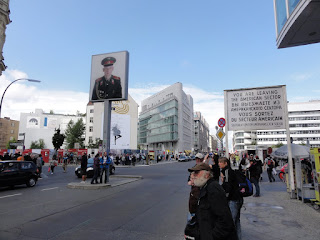 gigantic Hauptbahnhof (Main Railroad Station) and walked from there past the major government buildings, past the Reichstag again and over to the Holocaust Memorial. This is hard to describe. Lonely Planet’s Berlin City Guide says that it “consists of 2711 sarcophagi-like columns rising up in sombre silence from
gigantic Hauptbahnhof (Main Railroad Station) and walked from there past the major government buildings, past the Reichstag again and over to the Holocaust Memorial. This is hard to describe. Lonely Planet’s Berlin City Guide says that it “consists of 2711 sarcophagi-like columns rising up in sombre silence from  undulating ground.” Sometimes these columns are very short. Sometimes they are much taller than you are. They are laid out on a strict grid, but as you walk among them you have a sense of unease, because the ground level rolls up and down and the size of the columns gradually increases and decreases, for no perceptible reason. It is impressive and powerful, but you don’t know why.
undulating ground.” Sometimes these columns are very short. Sometimes they are much taller than you are. They are laid out on a strict grid, but as you walk among them you have a sense of unease, because the ground level rolls up and down and the size of the columns gradually increases and decreases, for no perceptible reason. It is impressive and powerful, but you don’t know why.
We went on to Checkpoint Charlie, which had been one of the main points for crossing the Berlin Wall. There is still the big sign in four languages: “YOU ARE LEAVING THE AMERICAN SECTOR.” Above the crossing there is a large
 photograph, in color, of an American soldier, on the other side of which is a photograph of a Russian soldier. There are also a couple of live “American soldiers” (with German accents) below, for the tourists to have their pictures taken with.
photograph, in color, of an American soldier, on the other side of which is a photograph of a Russian soldier. There are also a couple of live “American soldiers” (with German accents) below, for the tourists to have their pictures taken with.
We read the history of the Wall set out in text and photos along a wooden fence around a construction area right there, then decided not to visit the Museum at Checkpoint Charlie, which was about the Wall and people’s ingenious or deadly attempts to escape from East Germany over, under or through it.
Instead, we walked down to the Gendarmenplatz, the prettiest square in Berlin, to have a picnic lunch of the sandwiches that Mary Joy had made. We then had a coffee at an outdoor café next to the French Cathedral (built for the many French Calvinist Huguenots who had been welcomed to Berlin after the 1685
 revocation of the Edict of Nantes had ended religious toleration in France).
revocation of the Edict of Nantes had ended religious toleration in France).
Serendipitously, from our table, we saw a sign advertising an organ concert at that church in less than half an hour. We finished our coffees, went in and heard a short concert of some familiar baroque organ works. Mary Joy liked the organ but wasn’t impressed by the approach to the pieces. She thought it lacked planning, so the bits of each piece didn’t hang together (at least, that’s the impression that I, a non-musician, got of her critique!).

Then we went to the Nikolaiviertel, the oldest part of Berlin, where we took a quick look at the 13-century Nikolaikirche, whose spires are kind of like those of Assumption Church in downtown St. Paul, but much taller. Nearby is a museum dedicated to the turn-of-the-20th-century illustrator, caricaturist and photographer of the Berlin lower classes, Heinrich Zille. Mary Joy had heard about this from one of her German-language audio magazines, so we went in and saw some interesting pictures and part of a film about Zille's life.
Nearby there was a cute-looking cafe or tearoom, so we stopped in for coffee and soup (Mary Joy) and goodies (Marika and I).
We took the S-Bahn (aboveground)—or maybe it was the belowground U-Bahn—to the East Side Gallery, a 1.3-kilometer (0.6-mile) piece of the Wall that had been
 turned into a canvas for numerous peace-and-brotherhood-related murals in 1990, restored in 2009. We walked to the end of it, then across a 19th-century medievalist bridge over the Spree to the bohemian-ethnic Kreuzberg neighborhood, where we picked up an S-Bahn train back to Marika’s neighborhood. After a nice dinner prepared by our talented hostess, we retired to our apartment, to prepare for the trip to Dresden.
turned into a canvas for numerous peace-and-brotherhood-related murals in 1990, restored in 2009. We walked to the end of it, then across a 19th-century medievalist bridge over the Spree to the bohemian-ethnic Kreuzberg neighborhood, where we picked up an S-Bahn train back to Marika’s neighborhood. After a nice dinner prepared by our talented hostess, we retired to our apartment, to prepare for the trip to Dresden.
No comments:
Post a Comment